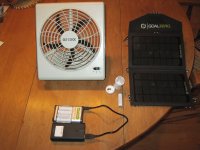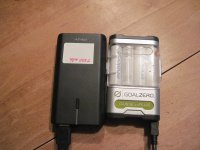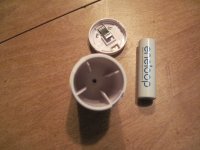Sitting out the drenching rains of Hermine seemed a perfect time to undertake an experiment to test the process of recharging a battery powered portable fan I keep in my truck and use for sleeping on warm nights.
TEST MATERIALS
1 8' diameter fan powered by
8 D cell adapter batteries (adaptor converts AA to D cell size)
8 Eneloop rechargeable AA batteries
1 Goal Zero AA/AAA battery charger with micro USB and solar inputs.
1 7800 mAh power bank with two USB outputs - 2A and 1A



Some time ago I took my fan, and using a fully charged set of AA batteries in the D cell adapter, ran it continuously on low speed for 10 hours. After 10 hours the fan was still turning but air movement was anemic. This battery arrangement clearly only provides you with one night of fan comfort.
TEST QUESTION: Without having access to an electrical outlet or your vehicle's power supply is there an easy way to recharge those 8 AA cells in time for the next night's use?
TEST CONDITIONS
1. Fan was run down until there was no blade movement, batteries totally tapped out.
TEST RESULTS
1. Using the faster 2A output of the power bank, 4 AA batteries were recharged 4 hours.
2. There was not enough left in the power bank to completely recharge the other 4 AA batteries.
CONCLUSIONS
1. Although they vary in capacity by Mfg, each AA battery has about a 2000 mAH capacity and the 7800 mAh power bank must have been nearly exhausted recharging 4 AA batteries.
2. Having 2 larger capacity power packs and a second AA charger would improve things.
3. Having two 15,000 mAh power packs and 2 AA chargers would allow the fan to be back in full service in 4 hours. This would provide three nights of fan use before having to use either an electrical power outlet, vehicle power source, or solar panel to recharge the AA batteries
4. Solar Panel will recharge 4 AA batteries in 3 hours with full sun.
COMPONENT COSTS
$17 ea or $34 15,000 mAh power pack
$ 25 for 8 Eneloop D cell Adaptors for AAs
$115 Goal Zero Solar kit (Includes Solar panel, AA/AAA charger, 4 AA batteries, connectors)
$50 Second Goal Zero AA/AA charger (Includes AA charger, 4 AA batteries, USB connector.
$20 8 Eneloop AA batteries. (not needed if you buy the solar kit and the extra charger as these will both have 4 AA batteries
$15 Fan
SUMMARY
For an investment of ~~$240 one could have a portable fan that would provide you with 3 nights of cooling before you require repowering your 8 AA cells from a source other than the 2 power packs. The solar panel is one power source but limited to 4 batteries at a time. Since you have another AA charger you could use your vehicle to recharge the second AA charger. The power packs can be recharged by the solar panel, but one at a time.
This is a fairly compact way to carry multiple days worth of AA and AAA batteries with you, And if you use AA or AAA for your illumination needs, this system has extra value. If your vehicle is near you, the dash board provides a convenient weather proof location to do your recharging using either power packs and/or the solar panels.
I like using the AAs with the D cell adaptors. The fan is much lighter and I avoid the expensive cost of replacing 8 D cells.



